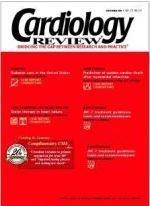Risk of stroke in patients with right atrial abnormalities
Atrial septal aneurysm and patent foramen ovale (PFO) have been
separately associated with stroke, and the combination confers an especially high risk for stroke. Additionally, the eustachian valve, a remnant of the right valve of the sinus venosus, which directs blood flow from the inferior vena cava to the fossa ovalis area in the fetal period, causes a significant right-to-left shunt in the presence of interatrial communication when prominent in adult life. Filamentous strands in the right atrium, which can span the eustachian valve to the atrial wall, are also a remnant of the right valve of the sinus venosus. An extensive network of strands known as Chiari’s network has been associated with paradoxical embolization, also presumably by directing inferior vena cava flow toward the fossa ovalis area.
Rodriguez and colleagues (page 31) hypothesized that septal aneurysm is associated with a large PFO and a prominent eustachian valve or right atrial filamentous strands. Thus, the combination of a large PFO and a structure in the right atrium that diverts the inferior vena cava flow toward the PFO would likely lead to an increased chance of paradoxical embolization.
The authors found that the presence of septal aneurysm was associated with a large PFO and a prominent eustachian valve or right atrial filamentous strands. Patients with septal aneurysm and PFO taking either warfarin or aspirin after stroke did not have an increase in the incidence of recurrent stroke, transient ischemic attacks (TIAs), or death. Patients with septal aneurysm, PFO, and right atrial anatomy predisposing to paradoxical embolization also had no difference in outcome compared with those without these factors. There was no significant difference in treatment results between those taking warfarin and those taking aspirin.
CLOSURE I is a prospective, multicenter, randomized, controlled trial to evaluate the safety and efficacy of the STARFlex® septal closure system versus best medical therapy in patients with a stroke and/or TIA due to presumed paradoxical embolism through a PFO. It is important to note that the CLOSURE I trial has not yet shown any definitive benefit of aspirin or warfarin to prevent recurrent stroke or death in patients with cryptogenic stroke and atrial septal abnormalities. Additionally, there was insufficient evidence regarding the effectiveness of either surgical or percutaneous closure of PFO in patients with TIA or a single stroke. Devices for PFO closure have been approved for patients who have had a second stroke while taking warfarin. The details of this can be found in PDF format via hyperlink at www.nmtmedical.com/closure1.
Conclusion
Patients at high risk for recurrent stroke with septal aneurysm, a PFO, and a prominent associated eusta-chian valve or with right atrial filamentous strands did not have a recurrent stroke when taking either warfarin or aspirin.
